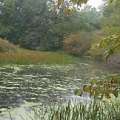 研究人員辨認出一類細菌,可去除某一種常見多氯聯苯的毒性。多氯聯苯是致癌物質,簡稱PCBs,曾被用做冷卻劑或潤滑劑,美國有超過250個地點遭其污染,其中包括湖泊與河床沉積物。此項發現是邁向生物復育法(bioremediation)的第一步,讓多氯聯苯的毒性可以自然化解,而無需冒險移除受污染的沉積物。
研究人員辨認出一類細菌,可去除某一種常見多氯聯苯的毒性。多氯聯苯是致癌物質,簡稱PCBs,曾被用做冷卻劑或潤滑劑,美國有超過250個地點遭其污染,其中包括湖泊與河床沉積物。此項發現是邁向生物復育法(bioremediation)的第一步,讓多氯聯苯的毒性可以自然化解,而無需冒險移除受污染的沉積物。
目前最常以疏浚掏沙後掩埋的方式,清理多氯聯苯,而研發以生物復育清除多氯聯苯的科技,將提供新的選擇。掏沙法向來多有爭議,因其採用侵入性技術,又有造成污染物擴散的風險。
早在20多年前,研究人員就知道自然界存在有微生物可緩慢移除多氯聯苯所含的氯。多氯聯苯曾被工業界廣泛應用。由於此類化學物質會毒害人體與動物,美國在1977年便禁止生產。
研究多氯聯苯的專家畢達德(Donna Bedard)與喬治亞理工的微生物學家合作,進行生物分解Aroclor 1260的研究,這是一種常見且氯化程度極高的多氯聯苯混合物。(譯註:通常氯化程度越高的多氯聯苯毒性越強)
合作團隊分析了胡薩通尼克河(Housatonic River)的沉積物樣本,發現是Dehalococcoides類(簡稱Dhc)的細菌在Aroclor 1260上產生去氯作用。
這些微生物用氫原子取代Aroclor 1260的氯原子,藉以獲取生長所需的能量,並啟動多氯聯苯的分解過程。喬治亞理工土木與環工學院的盧夫勒(Löffler)副教授解釋,當Aroclor 1260含有的氯被Dhc細菌去除到一定程度之後,其他的微生物就能進一步分解多氯聯苯,將毒性完全消除。
盧夫勒表示:「辨識出分解Aroclor的細菌是關鍵步驟。現在我們可以著手設計工具,在沉積物中尋找此類微生物,並研發工程技術,在河川或湖泊沉積物中激發這些細菌生長與活動。」相關研究結果發表於4月15日的《應用與環境微生物學》期刊(Applied and Environmental Microbiology)。
Researchers have identified a group of bacteria that can detoxify a common type of polychlorinated biphenyls, PCBs. These carcinogenic compounds, once used as coolants and lubricants, have contaminated more than 250 U.S. sites, including lake and river sediments. The discovery is a first step toward a bioremediation strategy that would naturally detoxify the PCBs without risky removal of the sediments in which they persist.
Development of bioremediation technologies for PCB cleanup would offer an alternative to sediment dredging and disposal in landfills, which is the most commonly used method for removing PCBs used today. Dredging is controversial because of the invasive nature of this technology and the risk of spreading contaminants.
Researchers have known for more than 20 years that naturally occurring microorganisms could slowly dechlorinate PCBs, which were once commonly used by industry. The compounds were banned from production in the United States in 1977 because of their toxicity to humans and animals.
PCB expert Donna Bedard collaborated with microbiologists at the Georgia Institute of Technology to study microbial degradation in Aroclor 1260, a common, highly chlorinated PCB mixture.
Working with sediment samples from the Housatonic, the team was able to determine that bacteria in the Dehalococcoides, Dhc, group were responsible for the dechlorination of Aroclor 1260.
These microbes replace the chlorine atoms in Aroclor 1260 with hydrogen, which fuels their growth and initiates the PCB degradation process. Once Dhc bacteria dechlorinate Aroclor 1260 to a certain level, other microbes will degrade it further and completely detoxify PCBs, explained Frank Loeffler, an associate professor in the Georgia Tech School of Civil and Environmental Engineering and the School of Biology.
"Identifying the bacteria responsible for Aroclor degradation represents a crucial step. Now we can start to design tools to look for these microbes in sediments and then develop engineering approaches to stimulate their growth and activity in river or lake sediments," Loeffler said.
全文及圖片詳見 ENS報導




